
Station Name:LANGFORD & ULTING[Source:
Nick Catford]
Langford & Ulting Photo Gallery 1: 1905 - April 1964  The basic facilities that were provided at Langford station are clearly seen in this view c1905. A this time Langford had a Station Mistress, her house is seen behind the platform.
Copyright photo from John Alsop collection 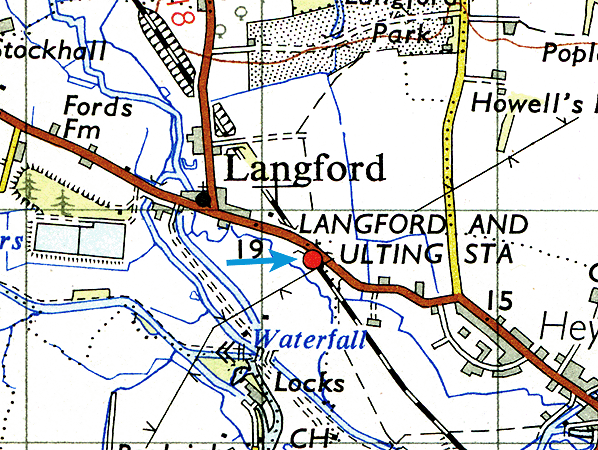 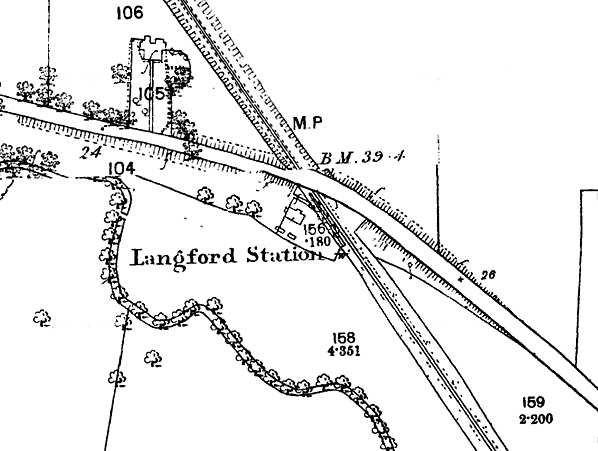
1874 1:2,500 OS map shows the station after the second track was lifted. There is clearly sufficient room for two tracks. The access path from Langford Road is seen close to the bridge. No shelter is
. shown on the platform. 
1897 1:2,500 OS map. The platform has been lengthened and now has a shelter. A signal box has also been provided opposite the platform. The access path from Langford Road shows steps.

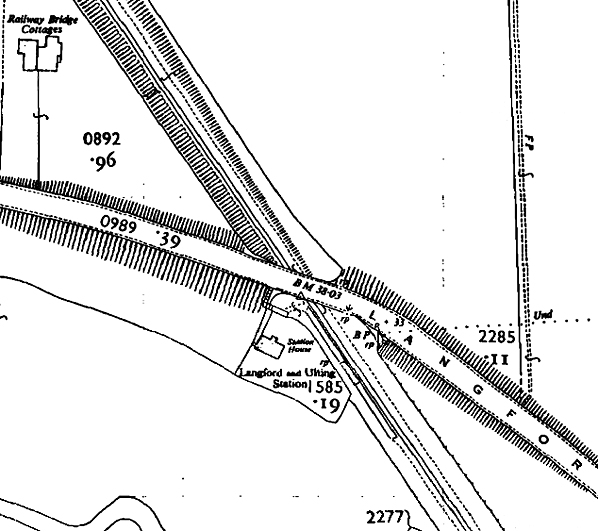
1956 1:2,500 OS map. The station is now identified as Langford and Utling but nothing else has changed.
ulting_old3.jpg) Langford & Utling station looking south-east in 1957.
Photo from John Mann collection
ulting_old4.jpg)
Langford Station c late 1950s. The platform shelter remained unchanged throughout the 20th century. Access to the station was along a path from Langford Road at the north end of the platform.
Photo
from John Mann collection
ulting_old5.jpg) A Derby 'Lightweight' 2-car unit from the first production batch, built from about 1955, waits at Langford at Utling station in the early 1960s with a service for Witham.
Photo received from Glen Dersley 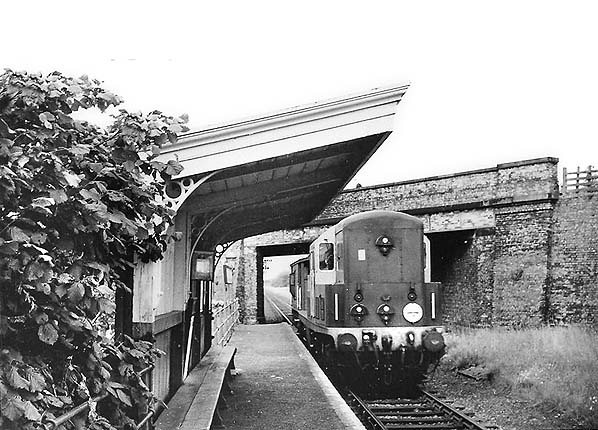 A goods train hauled by a class 15 diesel loco bound for Maldon East is seen at at Langford & Ulting Station looking north west in c early 1960s. Photo received from Glen Dersley ulting_old7.jpg) In its last few years a Waggon and Maschinenbau Railbus provided the service on the Witham - Maldon branch; seen here in April 1964, six months before closure. Railbuses were a very lightweight type of railcar designed specifically for passenger transport on little-used lines. In the late 1950s, British Rail tested a series of small railbuses, produced by a variety of manufacturers. These proved to be very economical, but also somewhat unreliable. Five railbuses were built in Germany in 1958 by Waggon und Maschinenbau for British Railways. Most of the lines worked by the railbuses were closed as a result of the Beeching cuts and all the vehicles were withdrawn by the end of the 1960s. Four have however survived into preservation.
Photo from John Mann collection
 Home Page Home Page
|
 BRIEF HISTORY OF RAILWAYS TO MALDON (Text taken from
BRIEF HISTORY OF RAILWAYS TO MALDON (Text taken from  Two bridges were built to cross the river Chelmer and the Chelmer and Blackwater navigation with a dock constructed alongside the canal. Where the track crossed the Causeway a level crossing was built and also an underpass for the passage of pedestrians and animals. The station also included a large goods yard and there were plans for a dock to be constructed within it so that goods could be taken directly from the boats to the goods trucks. Part of the uncompleted dock can still be seen today.
Two bridges were built to cross the river Chelmer and the Chelmer and Blackwater navigation with a dock constructed alongside the canal. Where the track crossed the Causeway a level crossing was built and also an underpass for the passage of pedestrians and animals. The station also included a large goods yard and there were plans for a dock to be constructed within it so that goods could be taken directly from the boats to the goods trucks. Part of the uncompleted dock can still be seen today.
 In 1862 Eastern Counties Railway was absorbed into the Great Eastern Railway who constructed the Maldon to Woodham Ferris line including the Maldon West Station which opened in 1889. This line linked Maldon with the newly constructed London to Southend-on-sea railway which had opened the same year. In 1923, both lines became part of the London and North Eastern Railway.
In 1862 Eastern Counties Railway was absorbed into the Great Eastern Railway who constructed the Maldon to Woodham Ferris line including the Maldon West Station which opened in 1889. This line linked Maldon with the newly constructed London to Southend-on-sea railway which had opened the same year. In 1923, both lines became part of the London and North Eastern Railway. 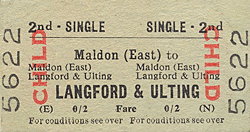 The Maldon East to Witham line continued with diesel replacing steam for both passenger and goods services but the 'Beeching axe' was falling on unprofitable lines and despite the public objection, it finally closed to passenger traffic in 1964. The goods service continued with a few trains a day carrying canned fruit and agricultural machinery until even that closed on April 15 1966. approximately half a mile of the branch from Witham station toward Maldon was used as a siding serving an industrial area for delivery of steel by railway, this section closed in the early 1980s after a rail strike. The track was lifted in 1969.
The Maldon East to Witham line continued with diesel replacing steam for both passenger and goods services but the 'Beeching axe' was falling on unprofitable lines and despite the public objection, it finally closed to passenger traffic in 1964. The goods service continued with a few trains a day carrying canned fruit and agricultural machinery until even that closed on April 15 1966. approximately half a mile of the branch from Witham station toward Maldon was used as a siding serving an industrial area for delivery of steel by railway, this section closed in the early 1980s after a rail strike. The track was lifted in 1969. 

